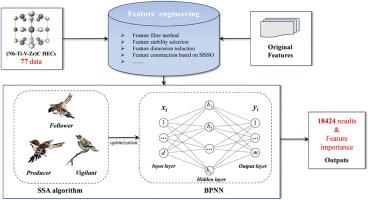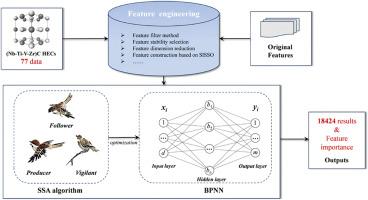Feature engineering via sure independence screening sparifying operator and sparrow search algorithm optimized artificial neural network reveals hardness descriptors for (Nb-Ti-V-Zr)C ceramics
IF 9.7
2区 材料科学
Q1 MATERIALS SCIENCE, MULTIDISCIPLINARY
引用次数: 0
Abstract
Replacing Nb by other rare metals M (M = V, Ti, W, Mo …) elements to vary the constituents of (Nb,M)C particle for surface modification has been an effective strategy to improve the wear resistance properties of engineering materials. However, due to the extensive X available solute contents and compositions, developing (Nb,M)C is still challenging. Herein, we tried to design quaternary Nb-based ceramics with multiple components including common elements for solid solution: Ti, V and Zr. With a combination of machine learning and virtual crystal approximation scheme, compositional space of predicted hardness for (Nb-Ti-V-Zr)C ceramics was constructed. A novel physical optimization algorithm named sparrow search algorithm (SSA) was first applied to optimize the input parameters including weight values and neuron threshold of back propagation neural network (BPNN). The hardness values of the predicted potential candidates with high hardness from the SSA-BPNN and first principles calculations are close, suggesting high predictive accuracy and good performance of the well-trained SSA-BPNN model. We further discussed the feature importance via introducing approaches from feature engineering including feature filter, feature dimension reduction and feature stability selection methods, and four features that contribute the most to hardness among the features were obtained. We also performed new feature construction by sure independence sparifying screening operator (SISSO) modelling, which was regarded as a more complicated pre-processing method, and two novel features were proposed based on the selected four features with the most significant feature importance.


特征工程通过确定独立筛选细化算子和麻雀搜索算法优化人工神经网络,揭示了(Nb-Ti-V-Zr)C陶瓷的硬度描述符
用其它稀有金属M (M = V, Ti, W, Mo…)元素代替Nb,改变(Nb,M)C颗粒的成分进行表面改性是提高工程材料耐磨性的有效策略。然而,由于广泛的X可用溶质含量和组成,开发(Nb,M)C仍然具有挑战性。在此,我们尝试设计具有多种组分的季元铌基陶瓷,包括常见的固溶体元素:Ti, V和Zr。采用机器学习和虚拟晶体近似相结合的方法,构建了预测(Nb-Ti-V-Zr)C陶瓷硬度的成分空间。提出了一种新的物理优化算法——麻雀搜索算法(SSA),用于优化bp神经网络(BPNN)的权重值和神经元阈值等输入参数。SSA-BPNN预测的高硬度潜在候选物的硬度值与第一性原理计算接近,表明训练良好的SSA-BPNN模型具有较高的预测精度和良好的性能。通过引入特征工程中的特征滤波、特征降维和特征稳定性选择方法,进一步讨论了特征的重要性,得到了特征中对硬度贡献最大的4个特征。我们还通过确定独立稀疏筛选算子(SISSO)建模进行了新的特征构建,这被认为是一种更复杂的预处理方法,并根据选择的四个特征重要性最显著的特征提出了两个新特征。
本文章由计算机程序翻译,如有差异,请以英文原文为准。
求助全文
约1分钟内获得全文
求助全文
来源期刊

Materials Today Physics
Materials Science-General Materials Science
CiteScore
14.00
自引率
7.80%
发文量
284
审稿时长
15 days
期刊介绍:
Materials Today Physics is a multi-disciplinary journal focused on the physics of materials, encompassing both the physical properties and materials synthesis. Operating at the interface of physics and materials science, this journal covers one of the largest and most dynamic fields within physical science. The forefront research in materials physics is driving advancements in new materials, uncovering new physics, and fostering novel applications at an unprecedented pace.
 求助内容:
求助内容: 应助结果提醒方式:
应助结果提醒方式:


